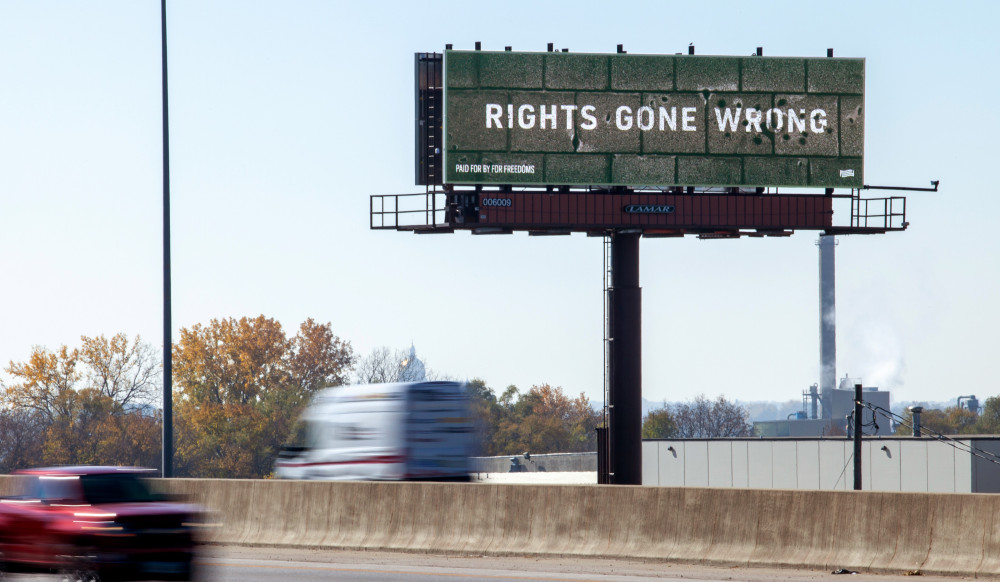Eric Gottesman: For Freedoms
To bring artists’ voices into the political sphere, Assistant Professor of Photography Eric Gottesman has launched a nationwide program to encourage public engagement through large-scale public art installations, town hall meetings, and gallery exhibitions.
The project, called For Freedoms, involves 200 arts institutions and universities in all 50 states that held events this fall in the run-up to the November midterm elections. At Purchase, an event last October featured a talk with Gottesman and his organization’s co-founder, artist Hank Willis Thomas.
Two courses this fall also contributed to the project. Students from Community Design, a graphic design course taught by Warren Lehrer, professor of art+design, created a 14 x 48-foot billboard. Gottesman’s visual arts class, called For Freedoms, developed a communications strategy for the national campaign and designed a billboard as well.
“Rights Gone Wrong” billboard in Des Moine, IA by students David McLachlan and Tanya Chernyak
“Our goal is to see how artists and artwork can change the kinds of conversations we have about civic engagement and political discourse,” says Gottesman, who joined the Purchase faculty in 2017. “We want creativity and art at the center of public life. And we want to transform art spaces into civic spaces.”
Gottesman launched the project in 2015, before Donald Trump’s nomination as the Republican Party’s standard bearer. Its first exhibition featured work by 60 artists at the Jack Shainman Gallery in Manhattan and led to a billboard campaign in 12 cities. One billboard, which was erected in Pearl, MS, depicted a historic scene from the civil rights march of 1963; it pictured legendary civil rights leader John Lewis crossing the Edmund Pettus Bridge in Selma, AL, facing a phalanx of police. The image was overlaid with the text: “Make America Great Again”—the rallying cry of then-candidate Trump’s campaign.
The billboard provoked a flurry of responses—from the Mississippi governor who wanted the artwork removed to liberal commentators questioning who was behind the effort to citizens who reflected on the underlying value of protest in our American democracy. The uproar thrust Gottesman into the media maelstrom and became yet another component of For Freedoms. “There was another mega-narrative involving how the press talked about what we were doing,” he says. “Talking to the press was a whole other element of the project.”
Gottesman’s involvement in the political sphere dates back to 2004. Helping run his father’s successful campaign for the New Hampshire State Senate connected him with the political process as a medium for his artistic expression.
The For Freedoms project has attracted funding from the Ford Foundation and Open Society Foundations. It is a nonpartisan effort that does not endorse specific candidates. The name is a nod to Norman Rockwell’s iconic Four Freedoms series (1941), inspired by Franklin D. Roosevelt’s Four Freedoms (1941): freedom of speech, freedom of worship, freedom from want, and freedom from fear.
“We want to question the assumptions about what constitutes political speech and free expression,” Gottesman says. A series of three billboards he developed last summer was inspired by questions asked by post-impressionist French artist Paul Gauguin: “Who are we? Where do we come from? Where are we going?”
Gottesman’s work also extends beyond the U.S. border. A billboard he created in the Middle Eastern country of Jordan approaches the issue of nationalism through an image of a broken fence against a desert mountain landscape. “The fence looks like a barrier, but it’s broken,” he explains. “It’s about the artificial lines drawn around national borders, which has coincided with all the talk about immigration. Given the difficulties on the individual and collective level, how do we navigate forward?”
